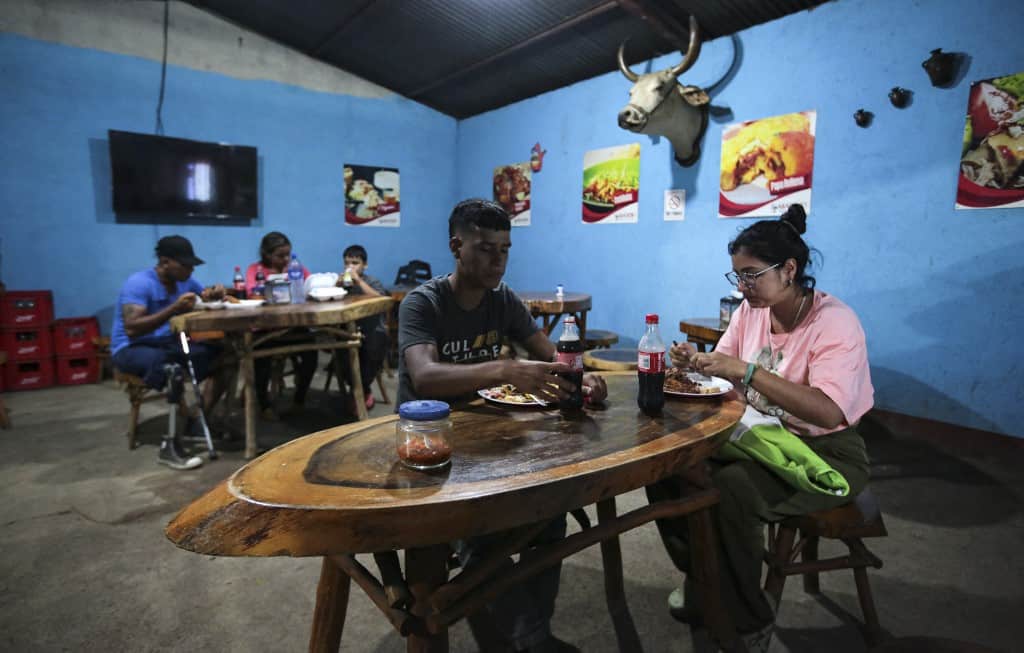While neighboring countries like Costa Rica take action to manage an influx of migrants, Nicaragua remains silent as thousands traverse its territory bound for the United States.
Venezuelan migrant Astrid Cuéllar described taking a brief rest stop in the Nicaraguan town of Condega, located 40 miles from the Honduran border. She was part of a group traveling by special bus lines that pause in the town daily so migrants can purchase food and water.
Cuéllar, 30, said she proceeds “with the risk of losing everything.” She said, “If they send us back and we lose everything, that’s one of the answers we don’t know.”
The government of President Daniel Ortega has not addressed the flow of migrants crossing Nicaragua chasing hopes of a better life in the U.S. This contrasts with other Central American nations that have increased border enforcement and set up camps to aid the travelers.
Per official data, over 400,000 migrants entered Honduras from Nicaragua so far this year, more than double the figure in 2022. A similar number have made the treacherous Darién Gap crossing from Colombia into Panama.
While Panama and Costa Rica assist migrants with shelter and transport, Nicaragua has been silent on the issue.
Backstory of Venezuelan Migrants
Cuéllar originally lived in the Venezuelan city of El Vigía, working in small business before the country’s economic catastrophe forced her to leave. She traveled overland with her 24-year-old brother José Gregorio Cuéllar.
Their bus journey spanned nearly 300 miles from the Costa Rican border to the capital Managua. There they switched buses to cover another 250 miles to the Honduran boundary at Las Manos. The overland transit of Nicaragua takes about 20 hours.
The siblings hope to send money back to Venezuela for Cuéllar’s three children and elderly parents once they find work in the U.S. But the uncertain outcome weighs on them.
“Guided by God and the Virgin, telling herself forward for the family, for gain, for progress,” Cuéllar said.
Danger for LGBT Migrants
Her brother José Gregorio is fleeing Venezuela due to discrimination over his sexuality. “I don’t feel safe in Latin America,” he explained. “I belong to the LGBT community, and I have received a lot of rejection.”
He aims to reach the U.S. for “more protection towards my sexuality.” Previously self-employed as an artist, he said incomes in Venezuela barely covered basic necessities.
During the brief rest stop in Condega, the Cuéllars purchase an inexpensive meal alongside other migrants at a roadside restaurant on the Pan-American Highway.
Scale of Central American Migration Unknown
Migrants from throughout the region join those transiting Nicaragua on the path north. The full extent of the exodus from Nicaragua itself remains unclear.
However, remittances from abroad have jumped 54 percent compared to last year. This suggests intensifying emigration since the political crisis of 2018, experts say. Along with the U.S., some Nicaraguans have fled to neighboring Costa Rica as well as Guatemala, El Salvador and Panama.
Venezuelan Aramis Tejedor, 42, also passed through Condega. He summarized the most emotionally wrenching part of the journey: “The hardest thing is saying goodbye to family members when leaving.”
Tejedor left a daughter and relatives behind in Caracas. He hopes to send money back once he secures employment in the United States.
After a brief rest, migrants pile back onto the buses to continue their uncertain quest. They travel the remaining 40 miles to the Nicaraguan border crossing into Honduras, where they receive clearance to carry on.
While their future remains unclear, most cling to the hope of better opportunities ahead. But the silence of the Nicaraguan government echoes loudly as this human tide passes through the country.







